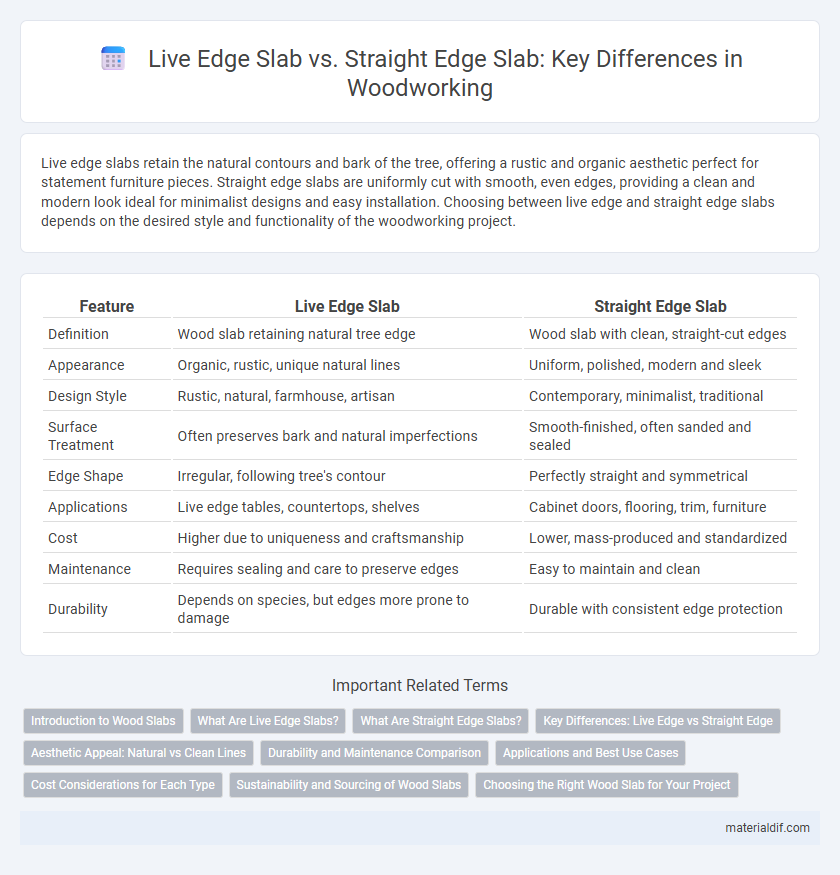Live edge slabs retain the natural contours and bark of the tree, offering a rustic and organic aesthetic perfect for statement furniture pieces. Straight edge slabs are uniformly cut with smooth, even edges, providing a clean and modern look ideal for minimalist designs and easy installation. Choosing between live edge and straight edge slabs depends on the desired style and functionality of the woodworking project.
Table of Comparison
| Feature | Live Edge Slab | Straight Edge Slab |
|---|---|---|
| Definition | Wood slab retaining natural tree edge | Wood slab with clean, straight-cut edges |
| Appearance | Organic, rustic, unique natural lines | Uniform, polished, modern and sleek |
| Design Style | Rustic, natural, farmhouse, artisan | Contemporary, minimalist, traditional |
| Surface Treatment | Often preserves bark and natural imperfections | Smooth-finished, often sanded and sealed |
| Edge Shape | Irregular, following tree's contour | Perfectly straight and symmetrical |
| Applications | Live edge tables, countertops, shelves | Cabinet doors, flooring, trim, furniture |
| Cost | Higher due to uniqueness and craftsmanship | Lower, mass-produced and standardized |
| Maintenance | Requires sealing and care to preserve edges | Easy to maintain and clean |
| Durability | Depends on species, but edges more prone to damage | Durable with consistent edge protection |
Introduction to Wood Slabs
Wood slabs are large, thick pieces of timber cut from a tree trunk, showcasing the natural grain and character of the wood. Live edge slabs retain the natural shape and bark of the tree, offering a rustic, organic aesthetic ideal for unique furniture designs. Straight edge slabs are milled with clean, uniform edges, providing a modern look and easier integration into traditional woodworking projects.
What Are Live Edge Slabs?
Live edge slabs preserve the natural contour and bark of the wood, showcasing organic shapes and unique character found in the tree's original form. This style highlights the raw beauty and texture of the wood, often used in custom furniture and artistic woodworking to emphasize natural aesthetics. Unlike straight edge slabs, live edge slabs maintain irregular edges that celebrate the tree's natural growth patterns and imperfections.
What Are Straight Edge Slabs?
Straight edge slabs are pieces of wood that feature clean, uniform edges cut precisely to create a consistent rectangular or square shape. These slabs are commonly used in cabinetry, furniture, and flooring due to their predictable dimensions and ease of installation. Unlike live edge slabs, which retain the natural bark and contours of the tree, straight edge slabs offer a modern, polished appearance ideal for minimalist and contemporary designs.
Key Differences: Live Edge vs Straight Edge
Live edge slabs retain the natural shape and bark of the tree, showcasing organic, irregular contours that emphasize rustic aesthetics and uniqueness. Straight edge slabs are milled with clean, uniform edges, allowing for precise alignment and a modern, polished appearance ideal for streamlined furniture. The choice impacts design flexibility, with live edge slabs highlighting natural beauty and straight edge slabs offering consistency and ease of integration.
Aesthetic Appeal: Natural vs Clean Lines
Live edge slabs showcase the organic, natural contours of the wood, preserving the tree's original shape and enhancing aesthetic appeal with unique, rustic charm. Straight edge slabs provide clean, uniform lines that emphasize modern minimalism and sleekness, appealing to contemporary design preferences. Choosing between live edge and straight edge slabs depends on whether the desired look favors natural, rugged beauty or polished, symmetrical elegance.
Durability and Maintenance Comparison
Live edge slabs retain the natural contours of the wood, often featuring irregular edges that enhance durability by preserving the original grain structure, which resists warping and cracking over time. Straight edge slabs undergo precise milling to create uniform edges, which facilitates easier maintenance due to standardized finishes but may sacrifice some natural strength and character. Both types require regular sealing and care to maintain longevity, with live edge slabs potentially demanding more attention to prevent moisture infiltration along organic edges.
Applications and Best Use Cases
Live edge slabs showcase the natural contours of wood, making them ideal for custom furniture, sculptural countertops, and artistic installations where organic aesthetics are prized. Straight edge slabs offer uniformity and ease of installation, best suited for cabinetry, flooring, and architectural millwork that require precise, clean lines. Selecting between live edge and straight edge slabs depends on the desired visual impact and application, with live edge emphasizing natural beauty and straight edge prioritizing structural consistency.
Cost Considerations for Each Type
Live edge slabs typically cost more than straight edge slabs due to the additional labor required to preserve the natural bark and irregular edges, increasing both production and finishing expenses. Straight edge slabs are more cost-effective as they involve standard milling and uniform cuts, reducing waste and simplifying installation. Pricing also varies with wood species and slab size, but live edge slabs generally command a premium in both raw materials and craftsmanship.
Sustainability and Sourcing of Wood Slabs
Live edge slabs preserve the natural contour of the tree, minimizing waste by utilizing wood that might otherwise be discarded, making them a more sustainable choice. Straight edge slabs typically require more processing and trimming, leading to higher material waste and increased environmental impact. Sourcing live edge slabs often involves harvesting from sustainably managed forests or reclaimed wood, promoting responsible forestry practices and reducing the demand for virgin timber.
Choosing the Right Wood Slab for Your Project
Live edge slabs showcase the natural contours and bark of the tree, offering unique, organic aesthetics perfect for rustic or contemporary designs. Straight edge slabs provide clean, uniform lines ideal for modern, minimalist projects requiring precise symmetry and easier joinery. Selecting the right wood slab depends on the desired style, functionality, and the finishing techniques compatible with your project's woodworking goals.
Live edge slab vs Straight edge slab Infographic

 materialdif.com
materialdif.com